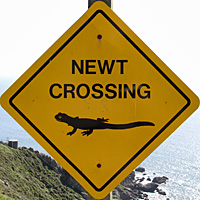|
| Terrestrial Phase Adults |
 |
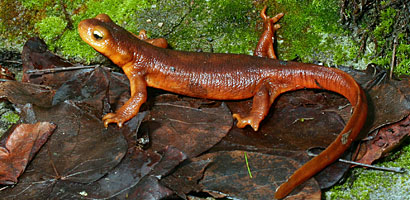 |
| Terrestrial phase adult, Mariposa County |
Terrestrial phase adult, Mariposa County |
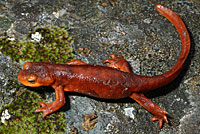 |
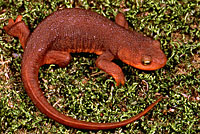 |
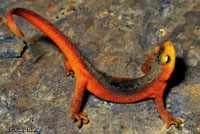 |
 |
| Terrestrial phase adult, Mariposa County |
Terrestrial phase adult,
Tuolumne County |
Defensive pose, Mariposa County |
Terrestrial phase adult,
Fresno County |
 |
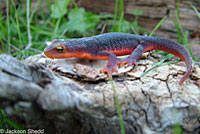 |
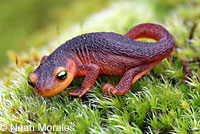 |
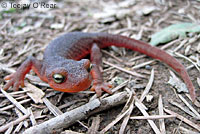 |
Adult, Placer County
© Teejay O'Rear
|
Adult female, terrestrial phase, Butte
County © Jackson Shedd |
Juvenile, Mariposa County
© Noah Morales |
Adult, El Dorado County
© Teejay O'Rear |
 |
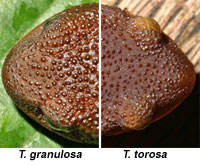
|
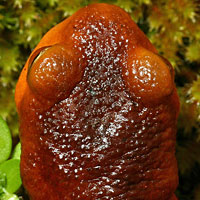 |
 |
| Adult, Butte County © Zachary Cava |
When seen from above, the eyes of
a Sierra Newt, T. sierrae, extend to or beyond the margin of the head, as they do on the California Newt, T. torosa.
Compare with T. granulosa, the Rough-skinned Newt, on the left and with other newts found in California here:
Newt Identification.
|
T. sierrae |
© Regan Sikola
Top: Rough-skinned Newt
Bottom: California Newt
This is a good illustration of how the eyes don't extend past the margin
of the head on T. granulosa
but they do on T. torosa and T. sierrae. |
| |
|
|
|
| Aquatic Phase Adults in the Breeding Season |
 |
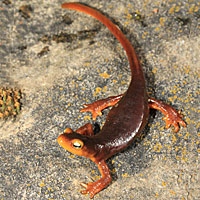 |
| Adult aquatic phase female, Fresno County, found in the water during the breeding season. |
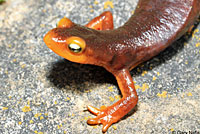 |
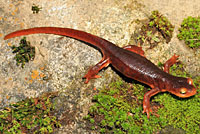 |
 |
 |
| Adult aquatic phase female, Fresno County, found in the water during the breeding season. |
Adult male, Fresno County, found on land during the breeding season. |
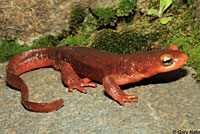 |
 |
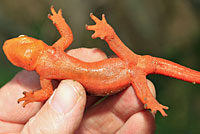 |
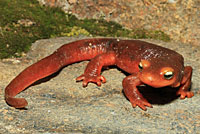 |
| Adult male, Fresno County, found on land during the breeding season. |
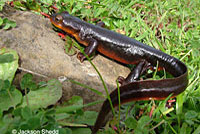 |
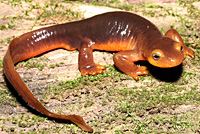 |
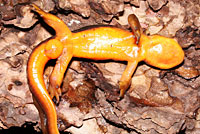 |
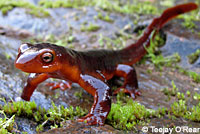 |
Adult male, aquatic phase, Butte
County © Jackson Shedd |
Aquatic phase breeding adult male, Butte County |
Adult, Placer County
© Teejay O'Rear |
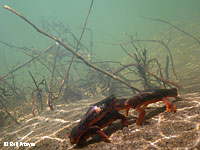 |
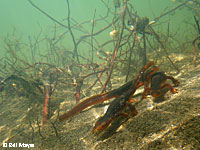 |
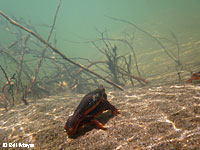 |
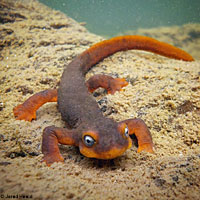 |
Adults breeding underwater at a shallow edge of the Yuba River in Nevada County in March.
Notice the egg sacks attached to sticks in the background. © Bill Mayer |
Adult, Shasta County © Jared Heald |
 |
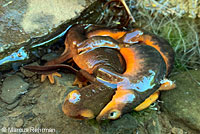 |
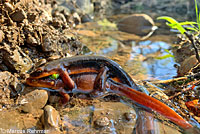 |
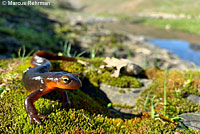 |
| Breeding adult male (on top) with breeding adult male Rough-skinned Newt (on bottom) found in the same pool of water. |
Adults in amplexus, Butte County
© Marcus Rehrman |
Adults in amplexus, Butte County
© Marcus Rehrman |
Adult in habitat, Butte County
© Marcus Rehrman |
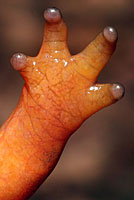 |
|
|
|
| During the breeding season, adult males develop nuptial pads on the toes to improve their ability to hold onto females during amplexus. |
|
|
|
| |
|
|
|
| Aberrant Sierra Newts |
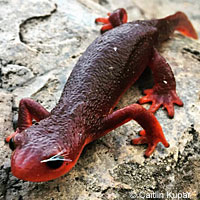 |
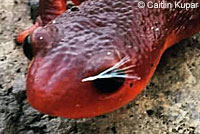 |
 |
|
| This adult newt has all black eyes. It was found just north of the Middle Fork of the Kaweah River in Tulare County, where newts have been identified as mostly Taricha torosa, but since it is in the hybrid zone with Taricha sierrae, it could be either species or a hybrid. Both of these species typically have patches of gold coloring in the eyes. © Caitlin Kupar |
|
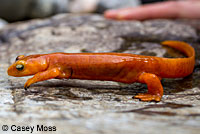 |
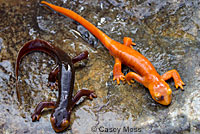 |
|
|
Hypomelanistic adult in breeding phase, Mariposa County
© Casey Moss |
Hypomelanistic adult (right)
Typical adult (left)
Both in breeding phase,
Mariposa County © Casey Moss |
|
|
| |
|
|
|
| Eggs |
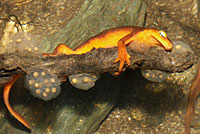 |
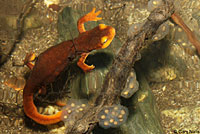 |
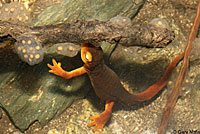 |
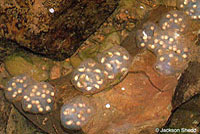 |
| Adult female underwater with several egg masses, Fresno County. |
Egg sacks attached to a rock in a creek, Butte County
© Jackson Shedd |
 |
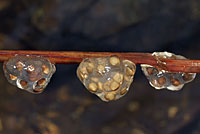 |
 |
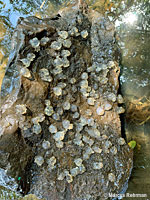 |
Eggs, Fresno County, attached to a plant stem.
Found underwater and pulled out briefly to photograph. |
Newts with eggs attached to submerged branches in a creek, Fresno County.
© Steven Britton |
Eggs attached to the bottom of a large rock in a Butte County stream
© Marcus Rehrman |
| |
|
|
| Larvae |
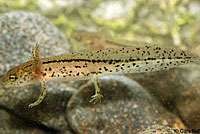 |
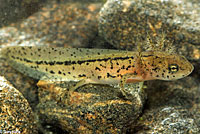 |
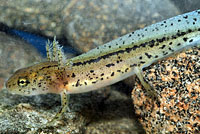 |
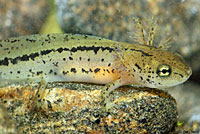 |
| |
Larvae underwater, Fresno County |
|
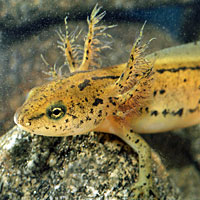 |
 |
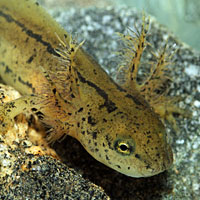 |
 |
| |
Larvae underwater, Fresno County |
|
 |
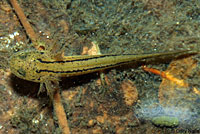 |
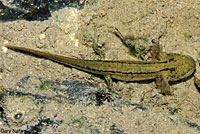 |
 |
| Larvae underwater, Fresno County |
Larvae in creek, Mariposa County
© William Flaxington |
| |
|
| Habitat |
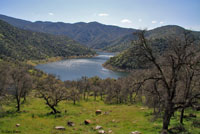 |
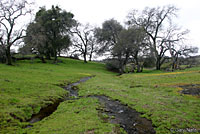 |
 |
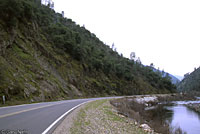 |
| Habitat, Fresno County |
Habitat, Butte County |
Habitat, Mariposa County |
Habitat, Mariposa County |
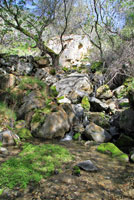 |
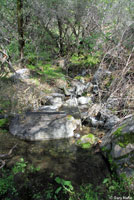 |
 |
 |
| Breeding pool, Fresno County |
Breeding pool, Fresno County |
Breeding pool in the forest,
Butte County |
Habitat, breeding creek,
Fresno County © Steven Britton |
 |
|
|
|
Kaweah River as it enters Lake Kaweah, Tulare County.
In the Sierra Nevada, Coast Range Newts are found south of the Kaweah River, while Sierra Newts are found north of the river. However, there is some overlap between the two around the river itself. |
|
|
|
| |
|
|
|
| Short Videos |
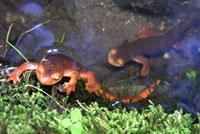 |
 |
 |
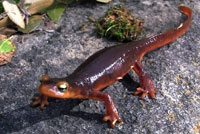 |
| A male newt, found crossing a road in the afternoon towards a breeding pool in a creek in Fresno County, is set down at the edge of the pool. He walks in and swims away quickly. Another male approaches him, either chasing him away from his territory or checking to see if he might be a female, and after only a few minutes in the pool, the new guy climbs back out of the water. |
A Sierra newt crosses a road on a March afternoon in Fresno County. |
A female Sierra Newt clings to several recently-laid egg masses in a shallow pool in Fresno County. |
Sierra Newts in motion. |
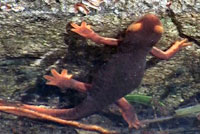 |
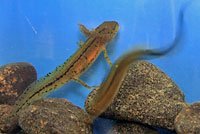 |
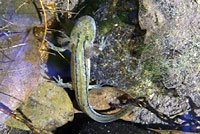 |
|
| Male newts move around a shallow breeding pool in the Sierra Nevada foothills in early March. |
Tiny Sierra Newt larvae move around underwater in a small aquarium. |
A tiny Sierra Newt larva crawls around on the bottom of a shallow pool in a slow-moving creek. |
|
|
|
|
|
| Description |
| |
| Size |
Adults are 2 3/4 - 3 1/2 inches long (7 - 8.9 cm) from snout to vent, and 4.9 - 7.8 inches (12.5 - 20 cm) in total length.
|
| Appearance |
A stocky, medium-sized salamander with rough, grainy skin in the terrestrial phase, and no costal grooves.
|
| Color and Pattern |
Terrestrial adults are yellowish-brown to dark brown above, burnt orange, sometimes yellowish, below.
(There is less contrast between dorsal and ventral color on sides than with T. granulosa.)
The eyelids and the area below the eyes are lighter than the rest of the head.
The iris is silvery to pale yellow.
The eyes appear to extend to or beyond the outline of the head when viewed from above, (unlike T. granulosa.)
|
| Male / Female Differences |
| Breeding males develop smooth skin, a flattened tail to aid with swimming, a swollen cloaca, and rough nuptial pads on the undersides of the feet to aid in holding onto females during amplexus. |
| Juveniles |
Aquatic larvae are the pond type, light yellow above with two dark regular narrow bands on the back.
|
| Comparison With Similar Species of Newts |
Identifying Species of Pacific Newts - Genus Taricha
|
| Life History and Behavior |
Rough-skinned when in the terrestrial phase.
Breathes through lungs. |
| Activity |
Terrestrial and diurnal, often seen crawling over land in the daytime, becoming aquatic when breeding.
(In some permanent bodies of water, adults retain their aquatic breeding phase characteristics and live in the water year-round.)
Sometimes seen moving in large numbers to aquatic breeding sites during or after rains during breeding season.
Terrestrial newts summer in moist habitats under woody debris, or in rock crevices and animal burrows, but can sometimes be seen wandering overland in moist habitat or conditions any time of the year.
|
| Longevity |
| Longevity is not known, but it has been estimated that California Newts can live for more than 20 years. |
| Defense |
When threatened, a newt will assume a swaybacked defensive pose, closing its eyes, extending its limbs to the sides, and holding its tail straight out. This "unken reflex" exposes its bright orange ventral surface coloring which is a warning to potential predators that the newt is poisonous.
Toxic Secretions
Sierra Newts have poisonous skin secretions containing the powerful neurotoxin tetrodotoxin that repel most predators. The poison is widespread throughout the skin, muscles, and blood, and even the eggs. It can cause death in many animals, including humans, if eaten in sufficient quantity. (One study estimated that 25,000 mice could be killed from the skin of one Rough-skinned newt, the most toxic of the Taricha species.)
The poison can also be ingested through a mucous membrane or a cut in the skin, so care should always be taken when handling newts.
Larvae are not poisonous and are preyed on by adult newts and other predators. Chemical cues from adult newts trigger larvae to seek cover.
Newt Predators
In most locations the Common Gartersnake, Thamnophis sirtalis, has a high resistance to tetrodotoxin which allows it to prey on Pacific Newts, genus Taricha. Thamnophis atratus and Thamnophis couchii have also been found with a strong resistance to tetrodotoxin that allows them to eat Pacific Newts.
Thamnophis elegans has also been found eating Taricha torosa in San Luis Obispo County.
(Feldman, Hansen, & Sikola. Herpetological Review 51[3] 2020.)
An arms race between T. sirtalis and the tetrodoxin poison contained in Taricha has been documented, with newt toxicity varying by location and snake resistance to the toxin also varying by location.
(Edmund D. Brodie III. Patterns, Process, and the Parable of the Coffeepot Incident: Arms Races Between Newts and Snakes from Landscapes to Molecules. From In the Light of Evolution: Essays from the Laboratory and Field edited by Jonathan Losos (Roberts and Company Publishers). 2010.)
The Bay Area is the Center of an Evolutionary Race Between Hungry Snakes and Toxic Newts.
by Anton Sorokin. Bay Nature, April 6, 2022
Other Pacific Newt Predators
"...in southern California, two introduced predators, crayfish and mosquitofish, are causing serious [newt] declines ... via predation on egg masses and larvae."
(Kuchta, 2005)
"Jennings and Cook (1998) found that introduced bullfrogs (Rana catesbeiana) in Sonoma and Riverside counties not only eat larval California newts, but surprisingly also adults. Kats et al. (1998)"
(Kuchta, 2005)
Great Blue Herons are known to prey on newts by swallowing them whole. (Fellers et al., 2008)
Otters have been observed preying on Rough-skinned Newts in Oregon (Stokes, Northwestern Naturalist 96(1), 2015).
Stokes et al, 2011, speculate that Ravens, crows and other Corvids may also contribute to newt predation as well as small carnivorous mammals such as skunks and raccoons, though they had no evidence yet to prove this.
(Amber N. Stokes, David G. Cook, Charles T. Hanifin, Edmund D. Brodie III, and Edmund D. Brodie Jr. Sex-biased Predation on Newts of the Genus Taricha by a Novel Predator and its Relationship with Tetrodotoxin Toxicity. The American Midland Naturalist 165(Apr 2011):389-399.)
|
| Sounds |
According to Davis and Brattstrom, California Newts produce a repertoire of sounds. (Davis, J. R. and B. H. Brattstrom. 1975. Sounds produced by the California newts, Taricha torosa. Herpetologica 31:409-412.) The sounds are very faint and difficult to hear over environmental sounds in the field. They did not determine how the newts were able to physically produce these different sounds. Breeding phase Coast Range Newts from Orange County were observed and recorded in a laboratory in a naturalistic setting where they were able to continue their typical social behaviors.
Three types of sounds were documented: clicks, squeaks, and whistles.
Clicks were the most commonly heard sounds. They were made when newts were put in an unfamiliar location, and when they were confronted by another newt. (The clicks appeared to be used to establish territories.)
Squeaks were made when a newt was picked up, and were sometimes accompanied by the newt twisting its body. The purpose of the squeak might be to startle a predator or to advertise the newt's toxicity.
The whistle was observed during breeding activity when a newt was touched in the middle of the back by a human or another newt, such as when a male newt climbed onto the back of another male newt. It was produced by males and females. The sound was not observed and could not be artificially evoked two weeks after breeding was over. This sound appears to be used in sex recognition and to establish hierarchical relationships, similar to the release call of a frog. |
| Diet and Feeding |
Adults eat small invertebrates such as worms, snails, slugs, sow bugs, and insects. They also consume amphibian eggs and larvae, including newt larvae and newt eggs. A small nestling bird was found in the stomach of one newt.
Larvae eat small aquatic invertebrates, decomposing organic matter, and possibly other newt larvae.
When feeding on the ground, adults feed by projecting a sticky tongue to capture prey. Aquatic adults open their mouth and suck the prey in. |
| Reproduction |
Reproduction is aquatic.
Adults probably reach reproductive maturity in their third year.
The breeding season lasts 6 - 12 weeks.
Typically, adults begin migrating to breeding streams in January and February.
In years with heavy precipitation, migration might occur in March and April after stream flow has subsided.
The Sierra Newt shows a strong tendency to use streams for breeding, but may use ditches and other bodies of water.
Breeding has been observed from early March through May.
Migration may take several weeks and cover large distances.
(In one study, California newts were recaptured up to nearly two miles (3,200 m) away from the breeding pond where they were originally captured and marked.) Newts have a strong homing instinct and typically return to the same breeding site each time they breed. This homing behavior has not been explained, but experiments show that it involves a sense of their body position, but it could also involve the sense of smell or a form of celestial navigation.
Males arrive first, and stay longer than females. In the water, males transform into their aquatic phase, with smooth skin that lightens in color, swollen cloacal lips, and tails enlarged and flattened to help them swim. Females develop smoother skin, but do not undergo as much change as males.
Males patrol the edges of the breeding waters, waiting from females to enter the water. When a female enters, she may be mobbed by a number of males who struggle to hold on to her until one male grabs on and cannot be removed. After a period of amplexus, where the male clutches the female from above, the male deposits a spermatophore and the female picks it up with her cloaca.
|
| Eggs |
Females lay and attach a spherical egg mass to the sides and bottoms of stones and sticks in relatively fast-flowing water. Egg masses contain from 7 - 47 eggs. It is estimated from ovarian counts of 130 - 160 that females lay from 3 - 6 masses each. Egg masses are attached just below the surface of the water. If the water rises significantly or lowers and strands the eggs, the eggs will die.
Incubation times may vary at various locations, from 14 - 52 days. |
| Larvae |
The larval stage lasts several months. The average larval period at one location in the Bay Area was observed to be from March to October. Larvae transform and begin to live on land at the end of the summer or in early fall. Larvae have been found in the spring in Southern California that were completing their metamorphosis, meaning they had hatched the previous year and had continued developing over the winter, but it appears that overwintering by larvae is uncommon. Metamorphosis may be triggered by pond drying in some waters, but other factors that influence metamorphosis have not been determined. Metamorphosis takes about 2 weeks, as the tail fin is absorbed and the gills are reduced.
Transformed juveniles leave the water with adult coloration and characteristics and with a trace of gills remaining. At this time they cannot survive if kept in the water. Juveniles leave the natal pond and travel overland where it is assumed they take refuge and do not return to the water until they breed.
|
| Habitat |
Inhabits grey pine-blue oak, and ponderosa pine communities. Better adapted to and more likely to breed in faster-flowing water than T. t. torosa.
|
| Geographical Range |
Endemic to California. Ranges along the western slope of the Sierra Nevada Mountains from northern Shasta county south to a zone of hybridization with the Coast Range Newt along the Kaweah River in Tulare County.
(Newts in the southern Sierra Nevada from the Kaweah River in Tulare County south to Mill Creek in Kern County were formerly recognized as Sierra Newts.) |
| Elevational Range |
Found up to about
6,500 ft. (2000 m.) (Stebbins & McGinnis 2012)
|
| Notes on Taxonomy |
Two subspecies of Taricha torosa have been traditionally recognized: T. t. sierrae, and T. t. torosa. In 2007, Shawn R. Kuchta1 showed that the two subspecies of Taricha torosa "constitute distinct evolutionary lineages and merit recognition as separate species: T. torosa (California newt) and T. sierrae (Sierra newt). " The contact zone between these two species is the southern Sierra Nevada with a "hybrid zone centered along the Kaweah River in Tulare County."
Alternate and Previous Names (Synonyms)
Taricha sierrae - Sierra Newt (Stebbins & McGinnis 2012)
Taricha torosa sierrae - Sierra Newt (Stebbins 1966, 1985, 2003)
Taricha torosa sierrae - ssp. of California Newt (Stebbins 1954)
Triturus sierrae - Sierra Newt (Bishop 1943)
Triturus torosus - Pacific Coast Newt (Brown Water Dog) (Storer 1925)
Taricha laevis (Baird & Girard 1853)
Notophthalmus torosus (Baird 1850)
Salamandra Beecheyi (Gray 1839)
Triturus torosus - (Rathke 1833)
|
| Conservation Issues (Conservation Status) |
No significant threats to Sierra Newts have been identified.
Populations of related Taricha along the coast have suffered population declines due to habitat loss and alteration caused by human activity, and from introduced predatory mosquitofish, crayfish, and bullfrogs, which eat the non-poisonous larvae and eggs. Breeding ponds have been destroyed for development, and stream pools used for breeding have been destroyed by sedimentation caused by wildfires. These may all be similar threats to the sierra subspecies. |
|
| Taxonomy |
| Family |
Salamandridae |
Newts |
Goldfuss, 1820 |
| Genus |
Taricha |
Pacific Newts |
Gray, 1850 |
Species
|
sierrae |
Sierra Newt |
(Twitty, 1942) |
|
Original Description |
Taricha torosa - (Rathke, 1833) - in Eschscholtz, Zool. Atlas, Pt. 5, p. 12, pl. 21, fig. 15
Taricha torosa sierrae - Twitty, 1942 - Copeia, p. 65, pl. 1 and 4
from Original Description Citations for the Reptiles and Amphibians of North America © Ellin Beltz
|
|
Meaning of the Scientific Name |
Taricha - Greek = preserved mummy, possibly referring to the rough skinned appearance
sierrae - refers to the type locality in the Sierra Nevada Mountains
from Scientific and Common Names of the Reptiles and Amphibians of North America - Explained © Ellin Beltz
|
|
Related California Salamanders |
Taricha torosa - Coast Range Newt
Taricha rivularis - Red-bellied Newt
Taricha granulosa - Rough-skinned Newt
|
|
More Information and References |
California Department of Fish and Wildlife
AmphibiaWeb
Movie of a Newt Feeding
Hansen, Robert W. and Shedd, Jackson D. California Amphibians and Reptiles. (Princeton Field Guides.) Princeton University Press, 2025.
Stebbins, Robert C., and McGinnis, Samuel M. Field Guide to Amphibians and Reptiles of California: Revised Edition (California Natural History Guides) University of California Press, 2012.
Stebbins, Robert C. California Amphibians and Reptiles. The University of California Press, 1972.
Flaxington, William C. Amphibians and Reptiles of California: Field Observations, Distribution, and Natural History. Fieldnotes Press, Anaheim, California, 2021.
Nicholson, K. E. (ed.). 2025. Scientific and Standard English Names of Amphibians and Reptiles of North America North of Mexico, with Comments Regarding Confidence in Our Understanding. Ninth Edition. Society for the Study of Amphibians and Reptiles. [SSAR] 87pp.
Samuel M. McGinnis and Robert C. Stebbins. Peterson Field Guide to Western Reptiles & Amphibians. 4th Edition. Houghton Mifflin Harcourt Publishing Company, 2018.
Stebbins, Robert C. A Field Guide to Western Reptiles and Amphibians. 3rd Edition. Houghton Mifflin Company, 2003.
Behler, John L., and F. Wayne King. The Audubon Society Field Guide to North American Reptiles and Amphibians. Alfred A. Knopf, 1992.
Robert Powell, Roger Conant, and Joseph T. Collins. Peterson Field Guide to Reptiles and Amphibians of Eastern and Central North America. Fourth Edition. Houghton Mifflin Harcourt, 2016.
Powell, Robert., Joseph T. Collins, and Errol D. Hooper Jr. A Key to Amphibians and Reptiles of the Continental United States and Canada. The University Press of Kansas, 1998.
American Museum of Natural History - Amphibian Species of the World 6.2
Bartlett, R. D. & Patricia P. Bartlett. Guide and Reference to the Amphibians of Western North America (North of Mexico) and Hawaii. University Press of Florida, 2009.
Bishop, Sherman C. Handbook of Salamanders. Cornell University Press, 1943.
Lannoo, Michael (Editor). Amphibian Declines: The Conservation Status of United States Species. University of California Press, June 2005.
Petranka, James W. Salamanders of the United States and Canada. Smithsonian Institution, 1998.
1 Herpetologica, 63(3), 2007, 332–350 E 2007 by The Herpetologists’ League, Inc.
Contact Zones and Species Limits: Hybridization Between Lineages of the California Newt, Taricha torosa, in the southern Sierra Nevada
Shawn R. Kuchta
|
|
|
The following conservation status listings for this animal are taken from the July 2025 State of California Special Animals List and the July 2025 Federally Listed Endangered and Threatened Animals of California list (unless indicated otherwise below.) Both lists are produced by multiple agencies every year, and sometimes more than once per year, so the conservation status listing information found below might not be from the most recent lists, but they don't change a great deal from year to year.. To make sure you are seeing the most recent listings, go to this California Department of Fish and Wildlife web page where you can search for and download both lists:
https://www.wildlife.ca.gov/Data/CNDDB/Plants-and-Animals.
A detailed explanation of the meaning of the status listing symbols can be found at the beginning of the two lists. For quick reference, I have included them on my Special Status Information page.
If no status is listed here, the animal is not included on either list. This most likely indicates that there are no serious conservation concerns for the animal. To find out more about an animal's status you can also go to the NatureServe and IUCN websites to check their rankings.
Check the current California Department of Fish and Wildlife sport fishing regulations to find out if this animal can be legally pursued and handled or collected with possession of a current fishing license. You can also look at the summary of the sport fishing regulations as they apply only to reptiles and amphibians that has been made for this website.
This salamander is not included on the Special Animals List, which indicates that there are no significant conservation concerns for it in California.
|
| Organization |
Status Listing |
Notes |
| NatureServe Global Ranking |
Not Known |
|
| NatureServe State Ranking |
Not Known |
|
| U.S. Endangered Species Act (ESA) |
None |
|
| California Endangered Species Act (CESA) |
None |
|
| California Department of Fish and Wildlife |
SSC |
California Species of Special Concern |
| Bureau of Land Management |
None |
|
| USDA Forest Service |
None |
|
| IUCN |
Not Known |
|
|
|
|
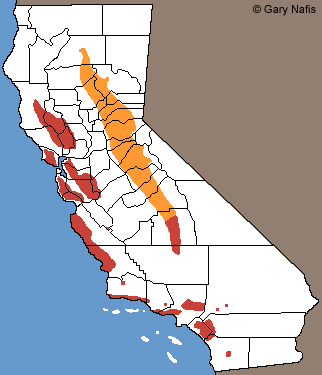 Orange: Range of this species in California
Orange: Range of this species in California